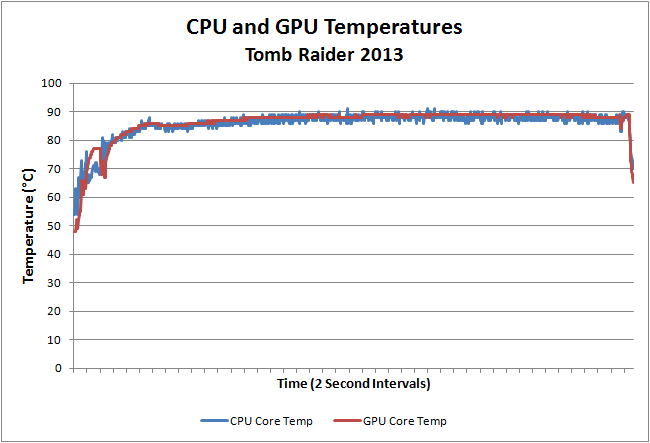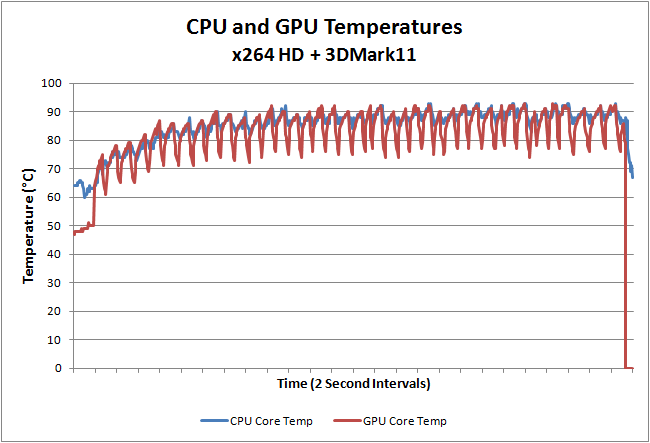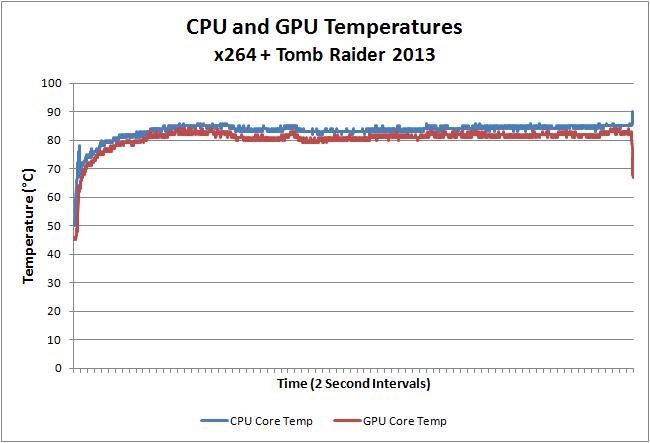Acer V7-482PG-9884 Review: Everything You Need
by Jarred Walton on August 24, 2013 12:00 AM ESTTemperatures
What happens to a slim, reasonably light, and reasonably powerful laptop when you put a sustained heavy load on the CPU and GPU? This is an area where we’ve seen quite a few laptops fall short; either they throttle CPU and/or GPU performance to cope with the heat (e.g. Dell’s XPS 15), or they get really hot – sometimes both! Logging CPU and GPU temperatures (and clock speeds) while the Aspire V7 runs a game (Tomb Raider), we get the following chart. (Note that the measurements are sampled at two second intervals, but the distance between hash marks on the x-axis is closer to one minute.)

Under most common gaming loads, in a matter of 10-15 minutes the V7 will reach the point where temperatures and clocks stabilize. In this case, the CPU and GPU temperatures are typically just under 90C, though the CPU did peak at 91C. That isn’t spectacular but it’s actually not too bad compared to other Ultrabooks that we’ve tested – Ultrabooks that didn’t have a dGPU. As far as clock speeds are concerned, the GPU stayed at a steady 1162.7MHz core/1800MHz RAM throughout the testing, so there’s no throttling on that part. Meanwhile, the CPU started at 2700-3000MHz (maximum Turbo Boost was achieved), and after a few minutes it settled into a comfortable 2400-2500MHz. (On a related note, stress testing with OCCT on the GPU caused the GPU to throttle down to a 758MHz core clock, so it was actually less strenuous than running a game like Tomb Raider.)

For our next stress test, we ran the x264 HD 5.0 encode on one CPU core (two threads) and 3DMark11 looping the four graphics tests on the GPU. This isn’t necessarily a worst-case stress test, but it’s the sort of load that we expect any well-designed system to handle without CPU temperatures breaking 95C (and preferably staying under 85C). The V7 does manage to stay under 95C, but just barely; we see temperatures of 93C on the CPU and 92C on the GPU within 10 minutes of launching our stress test, at which point the system basically enters steady-state – the GPU cools off a bit during scene transitions (analogous to level loads), and the CPU clock speeds range between 2100 MHz and 2700 MHz. So again the CPU isn’t running at maximum Turbo speed the whole time, but it does stay above the minimum guaranteed 1.8 GHz.

As a final stress test, the above is a plot of temperatures while running x264 HD with Tomb Raider – there’s no loading of levels this time, so the GPU is under a continuous load. The result is actually less demanding than the above stress test, at least in terms of temperatures, so apparently 3DMark11 manages to hit the GPU harder than Tomb Raider. Without the breaks between 3DMark11 scenes we don’t see any cyclical cooling down of the CPU and GPU, but the CPU clocks settle down at 2000-2100MHz this time while the GPU stays at the same 1163/1800MHz. The maximum temperature of the CPU this time is 87C – it actually gets hotter without the load on the GPU. The GT 750M meanwhile tops out at 84C.
I discussed overclocking of the GPU RAM a couple pages back, and you might be wondering what that does to the core temperatures. The answer: surprisingly little. I logged temperatures and clock speeds while running through our entire gaming suite, with very little idle time in between benchmarks. Throughout the entire set of benchmarks, the maximum CPU temperature was 87C and the maximum GPU temperature was 88C. I'd expect maybe a couple of degrees more than running at stock clocks, but GPU Boost may back off a little at times due to the increased power/heat from the GPU RAM, resulting in pretty much no significant change.
In the end, while we’d be happier with lower temperatures than what we’re seeing, the V7 still manages to deliver very good performance in a compelling form factor. The dual cooling fans with shared heatpipes appear to cope with the heat levels well enough for sustained use, though I’d recommend keeping the laptop on a desk or other flat surface when gaming or doing other computationally intensive work as the bottom of the V7 gets fairly toasty under load (mostly in the back-center area). Having the V7 on your lap will also tend to block the air intakes that are located on the bottom, right where the laptop would be resting on your thighs. It's not a problem for casual use, but under load it's pretty warm.
Noise Levels
There’s generally a close relationship between temperatures and noise levels; some laptops spin their fans faster and generate more noise in order to keep temperatures down, while others let the CPU and GPU get a little warmer in the hopes of reducing noise levels. The Acer V7 is better than most laptops in that maximum noise output during stress testing and gaming is 38.3dB, while at idle the laptop is generally silent (or at least below the 30dB noise floor of my equipment and location). The use of two apparently lower RPM fans instead of a single fan helps here as well.
I did cover both of the vents while running Tomb Raider to see if I could trigger a higher fan speed, but I was unable to do so – for better or worse, the fans appear to be maxed out at 38dB. Even temperatures weren’t any worse with covered vents; instead, the GPU clocks dropped slightly to 967MHz, which apparently was enough to keep the system below 90C. If you happen to be in a hotter environment (like Brian in Arizona during the summer), the V7 may run a bit slower to deal with the added heat, but it’s not a major concern. For reference, my testing location in Washington ranged from 60-90F (15-32C), so while a 50C ambient temperature would be far less accommodating, I can’t say that shag carpet with a towel covering the exhausts is any better suited for running games on a laptop.










62 Comments
View All Comments
damianrobertjones - Tuesday, August 27, 2013 - link
"I’m frequently amazed at how much better battery life is with Apple hardware under OS X" - I didn't see this in the last gen of macbooksI hope that this machine, as well as the Sony, is mentioned in future battery sections as the Mac DOES NOT PROVIDE the best battery life.
http://www.pcpro.co.uk/reviews/laptops/383785/dell...
JarredWalton - Tuesday, August 27, 2013 - link
Their "Light" battery test is not the same test that we use, nor is it at the same brightness setting. The MacBook Air 13 Haswell model gets 11.03 hours while loading four web pages every 60 seconds with the LCD at ~200 nits. They measured 12.68 hours of battery life doing what? "The light-use test is the absolute longest you can expect the battery to last with careful power management." That sounds like they're doing nothing, equivalent to our old "Idle" battery life testing from last year, and possibly at minimum brightness.We haven't been doing Idle testing for 2013, but on laptops tested previously idle battery life was typically 20% to as much as 40% more than what we got on our Internet testing. Our new Light test is our old Internet test with the LCD at 200 nits, so basically take the MBA13 result and multiply by at least 1.2 to be fair, and possibly as much as 1.4. That means the MBA13 under OS X while idle could easily hit 15+ hours, which would be more than any Windows laptop manages with a similar size battery.
Basically, you have to make sure you're comparing apples to apples when it comes to battery life testing. If a site doesn't completely document how they're testing, you can't do that.
willstay - Wednesday, August 28, 2013 - link
"Anand didn’t test Windows battery life with the new MBA13" - I wish he did. No one has done it with MBA13 yet.ihleonard - Saturday, August 31, 2013 - link
Since these don't seem to be available/on display in store anywhere, I want to get some idea of what they feel like before I take the plunge and get one. Are there any Acers (or other laptops) with a similar keyboard feel that are widely available in store; I just want to make sure that the low travel is ok.Thanks
Otunia - Monday, September 2, 2013 - link
This PC shows why 16:9 screens are bad. I'm writing this comment on an old 16:10 laptop which is as wide as this new Acer and guess? My screen is 15" thanks to all those extra vertical pixels.There are two extra downsides of this PC: the memory limit at 12 GB (why not two 8+8 GB unsoldered slots? For the extra thinness? Who cares!) and the glossy screen. So even if the keyboard and the touchpad turn to be super we are left with a subpar screen and constrained memory. The rotational disk would be OK if it can be upgraded later on.
A good attempt but please try again. Hint: just clone the 16:10 matte MBP 15" and perfect it by letting people upgrade its parts.
Hrel - Tuesday, September 3, 2013 - link
While I'm sure Microsoft is pushing for manufacturers to include touchscreens; it adds NO value right now. So the problem then becomes, if you include a touchscreen you can't charge for it. Which means reduced margins. I'm certainly not going to pay for it. This thing is at least $100 too expensive.Looks like a good machine though, if I could find it on sale for 1K I'd probably buy it.
ziotoo - Sunday, September 8, 2013 - link
Hey jared (or any v7 owner)My laptop died and thought of upgrading to the acer v7
The question is: i do design on my laptop, both 2d (photoshop, vectorial, animation, video editing) as well as 3d (from cad to maya/max). This is the first mainstream laptop i see with a decent dedicated graphic solution, and since i also do photo retouching you pretty much sold me on the screen. I travel a lot and the v7 is light and has the perfect screen format for me. It's also 1000eur in europe, wich is a really good price for this kind of product.
The problem is the i5 cpu. I've had a first gen i7 (i think 720 qm) quad core cpu for the past years and it was enough for me. But i'm scared that the acer v7 will actually offer worse performance with its 4th gen dual core i5 than my old laptop. Am i right to be worried? And would an i7 4500u actually be much better, even though that's also a dual core? It's gettong very hard to find quad core cpus in the 2kg weight range.
Thanks a lot.
ziotoo - Sunday, September 8, 2013 - link
Forgot to add: the 14 inch configuration in europe only sports an i5. The rest is unchangedhellermercer - Friday, November 22, 2013 - link
I need powerfull speakers!!!!hellermercer - Friday, November 22, 2013 - link
I need powerfull speakers!!!!